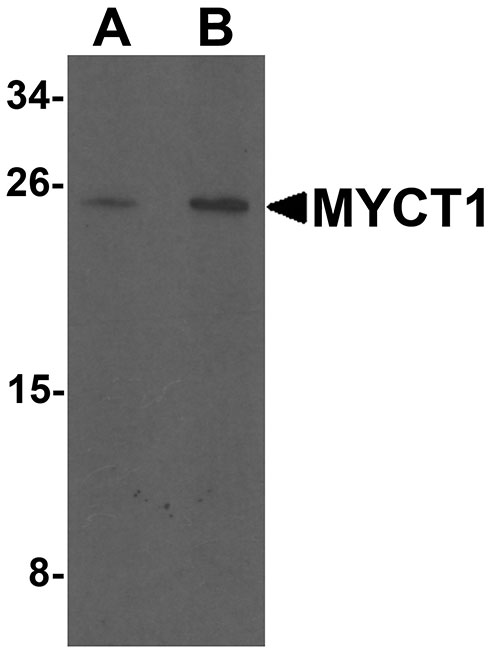MYCT1 Antibody
- 产品详情
- 实验流程
- 背景知识
Application
| WB, E |
|---|---|
| Primary Accession | Q8N699 |
| Other Accession | NP_079383, 156151389 |
| Reactivity | Human, Mouse, Rat |
| Host | Rabbit |
| Clonality | Polyclonal |
| Isotype | IgG |
| Calculated MW | 26593 Da |
| Concentration (mg/ml) | 1 mg/mL |
| Conjugate | Unconjugated |
| Application Notes | MYCT1 antibody can be used for detection of MYCT1 by Western blot at 1 - 2 µg/mL. |
| Gene ID | 80177 |
|---|---|
| Other Names | Myc target protein 1, Myc target in myeloid cells protein 1, MYCT1, MTLC, MTMC1 |
| Target/Specificity | MYCT1; At least two isoforms of MYCT1 are known to exist; this antibody will detect both isoforms. |
| Reconstitution & Storage | MYCT1 antibody can be stored at 4℃ for three months and -20℃, stable for up to one year. As with all antibodies care should be taken to avoid repeated freeze thaw cycles. Antibodies should not be exposed to prolonged high temperatures. |
| Precautions | MYCT1 Antibody is for research use only and not for use in diagnostic or therapeutic procedures. |
| Name | MYCT1 |
|---|---|
| Synonyms | MTLC, MTMC1 |
| Function | May regulate certain MYC target genes, MYC seems to be a direct upstream transcriptional activator. Does not seem to significantly affect growth cell capacity. Overexpression seems to mediate many of the known phenotypic features associated with MYC, including promotion of apoptosis, alteration of morphology, enhancement of anchorage-independent growth, tumorigenic conversion, promotion of genomic instability, and inhibition of hematopoietic differentiation (By similarity). |
| Cellular Location | Nucleus. Note=Expressed in nuclei of hepatocellular carcinoma cell line BEL-7402 cells |
| Tissue Location | Down-regulated in gastric cancer tissues. |
For Research Use Only. Not For Use In Diagnostic Procedures.
Provided below are standard protocols that you may find useful for product applications.
BACKGROUND
MYCT1 Antibody: MYCT1 was initially identified as a novel target of the c-Myc oncogene in myeloid cells. It is a widely expressed nuclear protein whose overexpression can promote apoptosis, alteration of morphology, enhancement of anchorage-independent cell growth, tumorigenic conversion, promotion of genomic instability, and inhibition of hematopoietic differentiation. MYCT1 binds to the promoters of several c-Myc-regulated genes and it has been suggested that the phenotypes seen in MYCT1-overexpressing cells are a result of the deregulation of these genes. RUNX1-ETO, a fusion protein made up of RUNX1 and ETO, is thought to deregulate the proliferation and responsiveness of human hematopoietic progenitor cells downstream of MYCT1.
REFERENCES
Yin X, Grove L, Rogulski K, et al. Myc target in myeloid cells-1, a novel c-Myc target, recapitulates multiple c-Myc phenotypes. J. Biol. Chem. 2002; 277:19998-20010.
Rogulski KR, Cohen DE, Corcoran DL, et al. Deregulation of common genes by c-Myc and its direct target, MT-MC1. Proc. Natl. Acad. Sci. USA 2005; 102:18968-73.
Liddiard K, Burnett AK, Darley RL, et al. RUNX1-ETO deregulates the proliferation and growth factor responsiveness of human hematopoietic progenitor cells downstream of the myeloid transcription factor, MYCT1. Leukemia 2012; 26:177-9.
终于等到您。ABCEPTA(百远生物)抗体产品。
点击下方“我要评价 ”按钮提交您的反馈信息,您的反馈和评价是我们最宝贵的财富之一,
我们将在1-3个工作日内处理您的反馈信息。
如有疑问,联系:0512-88856768 tech-china@abcepta.com.























 癌症的基本特征包括细胞增殖、血管生成、迁移、凋亡逃避机制和细胞永生等。找到癌症发生过程中这些通路的关键标记物和对应的抗体用于检测至关重要。
癌症的基本特征包括细胞增殖、血管生成、迁移、凋亡逃避机制和细胞永生等。找到癌症发生过程中这些通路的关键标记物和对应的抗体用于检测至关重要。 为您推荐一个泛素化位点预测神器——泛素化分析工具,可以为您的蛋白的泛素化位点作出预测和评分。
为您推荐一个泛素化位点预测神器——泛素化分析工具,可以为您的蛋白的泛素化位点作出预测和评分。 细胞自噬受体图形绘图工具为你的蛋白的细胞受体结合位点作出预测和评分,识别结合到自噬通路中的蛋白是非常重要的,便于让我们理解自噬在正常生理、病理过程中的作用,如发育、细胞分化、神经退化性疾病、压力条件下、感染和癌症。
细胞自噬受体图形绘图工具为你的蛋白的细胞受体结合位点作出预测和评分,识别结合到自噬通路中的蛋白是非常重要的,便于让我们理解自噬在正常生理、病理过程中的作用,如发育、细胞分化、神经退化性疾病、压力条件下、感染和癌症。






